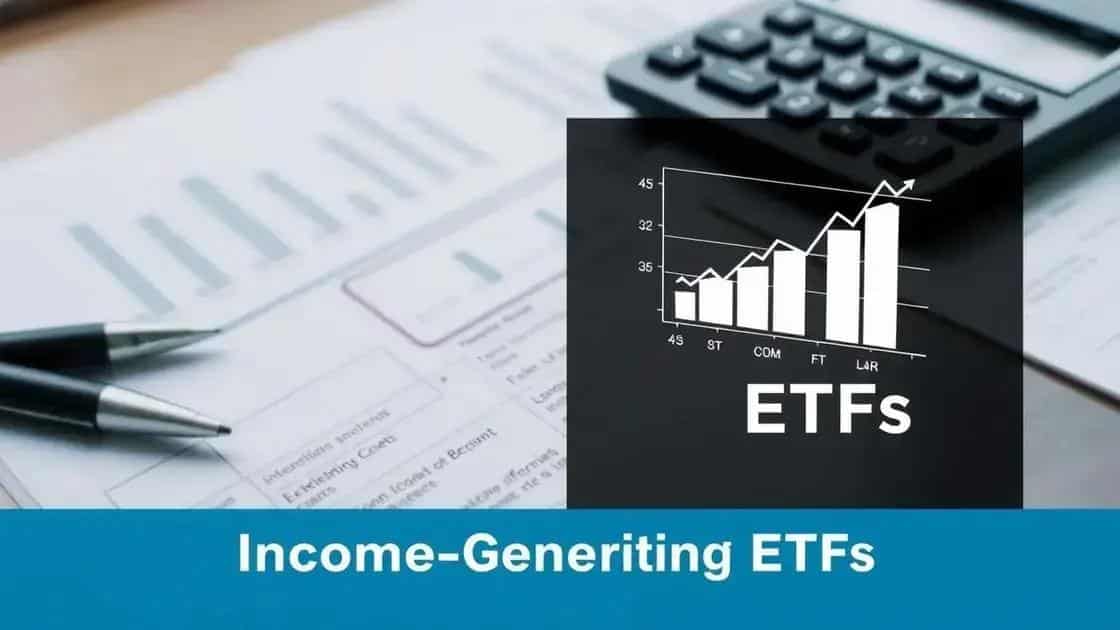Income-generating covered call ETFs: a smart investment choice

Income-generating covered call ETFs combine stock ownership with option selling, providing investors with a steady income stream while managing risk, but they come with limited upside potential and market volatility.
Income-generating covered call ETFs offer investors a unique way to create steady income while managing risk. Have you ever wondered how these investment products operate? Let’s dive into their mechanics and uncover the potential benefits!
Understanding covered call ETFs
Understanding covered call ETFs is essential for investors looking to generate consistent income. These funds combine the strategies of both stock ownership and option selling, allowing investors to potentially earn higher returns.
What are covered call ETFs?
A covered call ETF is an investment fund that holds stocks while simultaneously selling call options on those stocks. This strategy limits upside potential but aims to generate income through option premiums.
How do they work?
Here’s how covered call ETFs typically function:
- The ETF manager buys and holds a portfolio of stocks.
- The manager sells call options on those stocks, which gives buyers the right to purchase the underlying stocks at a set price.
- When the options expire worthless, the ETF retains both the stocks and the premium earned.
- If the options are exercised, the ETF sells the stocks but still profits from the premiums.
This combination of stock ownership and option selling can provide a source of income in various market conditions. For many investors, this can be an appealing alternative to traditional investment strategies.
An important aspect to consider is that while covered call ETFs can help in producing income, they may also limit potential gains if the stock prices rise significantly. Since the call options cap how much appreciation an investor can gain, one must weigh the benefits against the potential limitations carefully.
Overall, understanding the mechanics of covered call ETFs can lead to informed investment decisions. By recognizing how these funds operate, investors can determine whether they align with their financial goals and risk tolerance.
Benefits of income-generating ETFs

Understanding the benefits of income-generating ETFs can help investors make informed decisions. These funds provide a balance of growth and income, attracting a variety of investors.
Steady Income Stream
One of the main advantages of income-generating ETFs is their ability to deliver a consistent income stream. These ETFs typically invest in high-dividend-paying stocks or other income-producing securities. This makes them an ideal choice for those seeking regular cash flow.
Diversification Benefits
Diversification is essential in investing, and income-generating ETFs offer that benefit. By pooling various securities, these funds reduce the risk associated with holding individual stocks. A well-diversified ETF can minimize volatility and provide more stable returns.
- Access to a variety of industries
- Reduced exposure to market fluctuations
- Lower risk through diversified investments
Furthermore, income-generating ETFs are often more cost-effective than buying individual stocks. This is because they typically have lower expense ratios, making it easier to keep more earnings.
Many investors appreciate that these funds are easy to buy and sell on exchanges, just like stocks. This liquidity ensures that investors can quickly access their funds when needed. Overall, income-generating ETFs appeal to those looking for income without significant management hassles.
Tax efficiency is another notable benefit. Generally, qualified dividends from these ETFs are taxed at lower rates compared to standard income, resulting in more earnings for the investor.
Key strategies for investing
Understanding key strategies for investing in income-generating covered call ETFs can enhance your investment approach. By applying these strategies, you can optimize your returns while managing risks effectively.
Buy and Hold Strategy
One common strategy is the buy and hold approach. This means purchasing shares of income-generating ETFs and holding them over the long term. This strategy allows investors to benefit from dividends and leverage compound growth.
Dollar-Cost Averaging
Another effective method is dollar-cost averaging. This strategy involves regularly investing a fixed amount of money into covered call ETFs, regardless of their price. Over time, this reduces the impact of market volatility and can lower the average cost per share.
- Consistent investment even in down markets
- Lower overall purchase price
- Reduce emotional investing decisions
Furthermore, monitoring the performance of individual funds is crucial. Pay attention to factors like yield, expense ratios, and the underlying assets in the ETF. Choosing funds that meet your investment criteria enhances your potential for higher returns.
Additionally, investors should consider diversification across multiple income-generating ETFs. By spreading investments across different sectors and asset classes, you can mitigate risks associated with any single investment.
Staying informed about market trends and economic conditions can also provide valuable insights. Adjusting your investment strategy based on current events can lead to better decision-making and improved outcomes.
Risks to consider with covered call ETFs

When investing in covered call ETFs, it’s important to understand the risks involved. While these funds can provide income, they also have potential downsides that every investor should consider.
Limited Upside Potential
One major risk is the limited upside potential. By selling call options, investors cap their profits. If the stocks in the ETF rise significantly, the fund may not fully benefit from this price increase. This is a crucial factor to keep in mind for those who aim for high returns.
Market Volatility
Market volatility can also affect covered call ETFs. During unstable market conditions, the value of stocks may decline significantly. While the option premiums can provide a buffer, sharp declines can still lead to losses.
- Potential for losses in a bear market
- Declining stock values impact overall performance
- Investors may be forced to sell at a loss
Another risk is that not all funds are created equal. Some covered call ETFs may have higher expense ratios compared to others, which can eat into profits. Choosing the right fund is key.
Liquidity is also a factor. Some ETFs may not trade as frequently, making it harder to buy or sell shares without a significant price change. This can result in larger bid-ask spreads.
Lastly, tax implications can vary. Depending on how the fund manages its distributions, investors might face different tax treatments on short-term capital gains from options. Understanding these factors can help investors make better decisions.
FAQ – Frequently Asked Questions about Income-Generating Covered Call ETFs
What are covered call ETFs?
Covered call ETFs are investment funds that hold stocks while selling call options on those stocks to generate income.
What are the main benefits of investing in covered call ETFs?
The main benefits include a steady income stream, diversification, lower expenses, and potential tax advantages.
What are the risks associated with covered call ETFs?
Risks include limited upside potential, market volatility, liquidity issues, and varying expense ratios.
What strategies can I use for investing in covered call ETFs?
Common strategies include buy and hold, dollar-cost averaging, and regular monitoring of fund performance.





